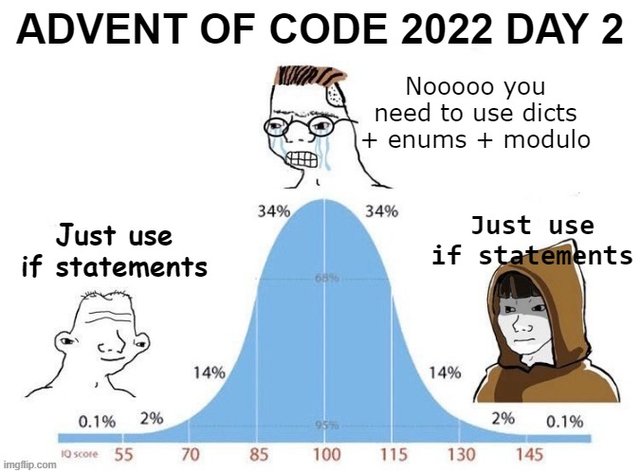The Elves begin to set up camp on the beach. To decide whose tent gets to be closest to the snack storage, a giant Rock Paper Scissors tournament is already in progress.
God the question’s description is always pure gold…now let’s jump right in.
We are given a string, our “strategy guide” that represents a rock, paper, scissors turn decision. The string is divided into two columns, the first represents the first player’s decision and the second ours. For example:
|
|
We are also told the following: For player 1 - A = Rock, B = Paper, C = Scissors For player 2 - X = Rock, Y = Paper, Z = Scissors We are also given a score table for the outcome and the decision we made, for example, a win is 6 points and choosing paper is 2 points, etc…
Like previous questions, we’ll start by parsing our input
Parsing
We can go (see what I did there?) with several options to represent our game but in my opinion, an array of tuples is the simplest option
|
|
The make function allocates a piece of memory in a certain, specified size for our array
Part 1
We are asked to provide our total score if we play exactly as instructed in the strategy guide.
Let’s think about this for a bit, there are several ways we can solve this, we can use a bunch of if statements or some fancy pattern matching, since go does not have pattern matching and I don’t want to write a ton of if statements we will go with a hybrid approach.
We will create 3 different mappings:
- Represents the points we get for our choice e.g rock, paper, or scissors
- Winning state, meaning If we choose X what does the other player need to choose for us to Win
- Tie state, essentially the same as .2
|
|
We don’t take into account the losing state since its essentially a no-op (0 points)
Building on top of these maps and our parsing logic, we can now solve the first part with the following code
|
|
At each loop iteration we first add the points based on our choice score += scores[my] then we check if his move is what we need based on our player choice, to win or get a tie, and if it is we add the necessary points to our total score.
Part 2
In part two the sneaky elves switch things up a bit.
Instead of our column representing our moves, it represents the turn outcome where X = lose, Y = tie, and Z = win and we need to choose our choice accordingly.
For example, let’s look at the first turn A Y, the new meaning of this pair is “player one chose Rock, and the game ended in a tie” building on this information we can create new mappings, the new mappings will be between player 1 choice and the choice player 2 need to make to get to a certain state e.g winning, losing, tie, etc…
Since it’s pretty similar to part 1, we will jump right ahead and look at part 2 as a whole
|
|
For each desired state we check what move we need to do based on player 2 choice and pass it down to the scores map.
That’s it we are all done with paper, rock, scissors and I must admit that I didn’t think it can be so confusing 🤣
You can find the complete code here Thanks for reading!
This post is number 3 of a 13 posts series > Learning Go.
